Abstract
Methylprednisolone sodium succinate limited the ability of zymosan or lipopolysaccharide to activate complement in normal serum by the alternative amplification pathways. Methylprednisolone limited B consumption in a reaction mixture which contained purified C3b, D, and B, indicating that soluble steroid directly inhibited the amplification pathway. The ability of soluble steroid to inhibit events in the alternative and amplification pathways of complement may provide a partial explanation for the effectiveness of steroids in treating gram negative septic shock.
Full text
PDF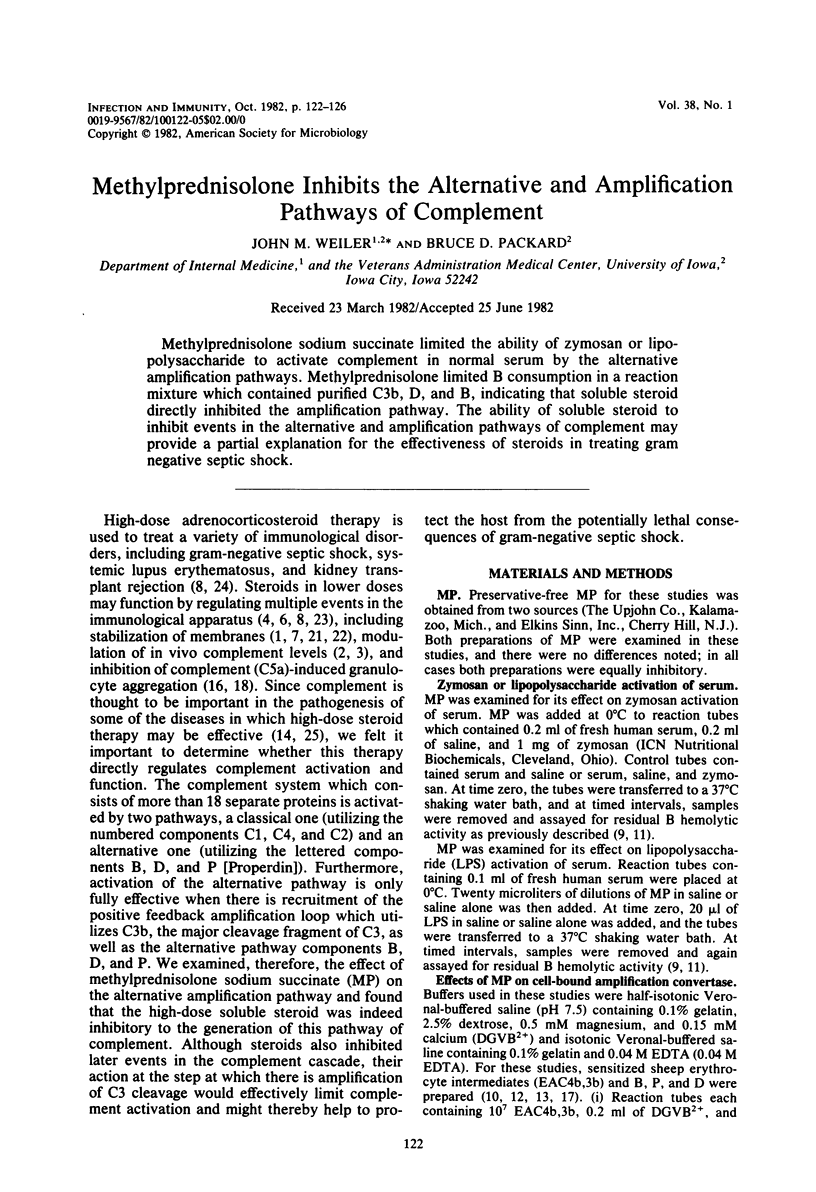
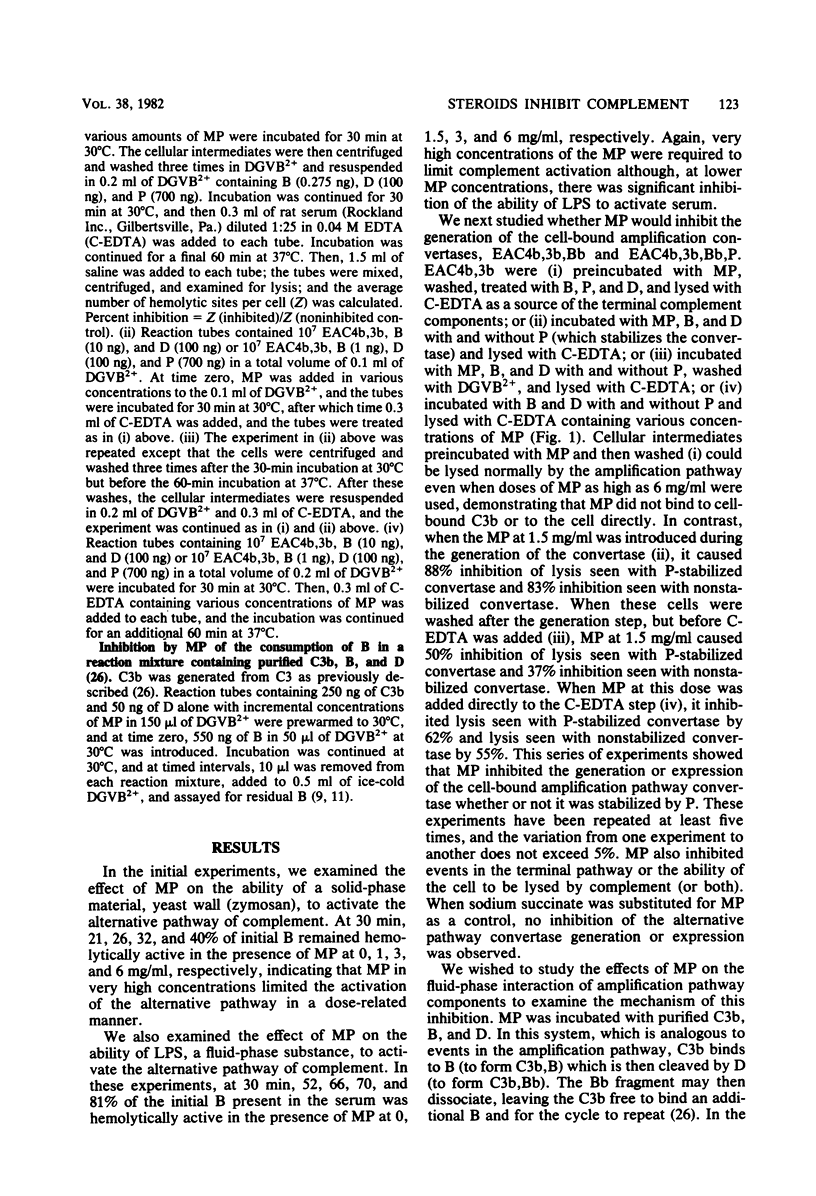
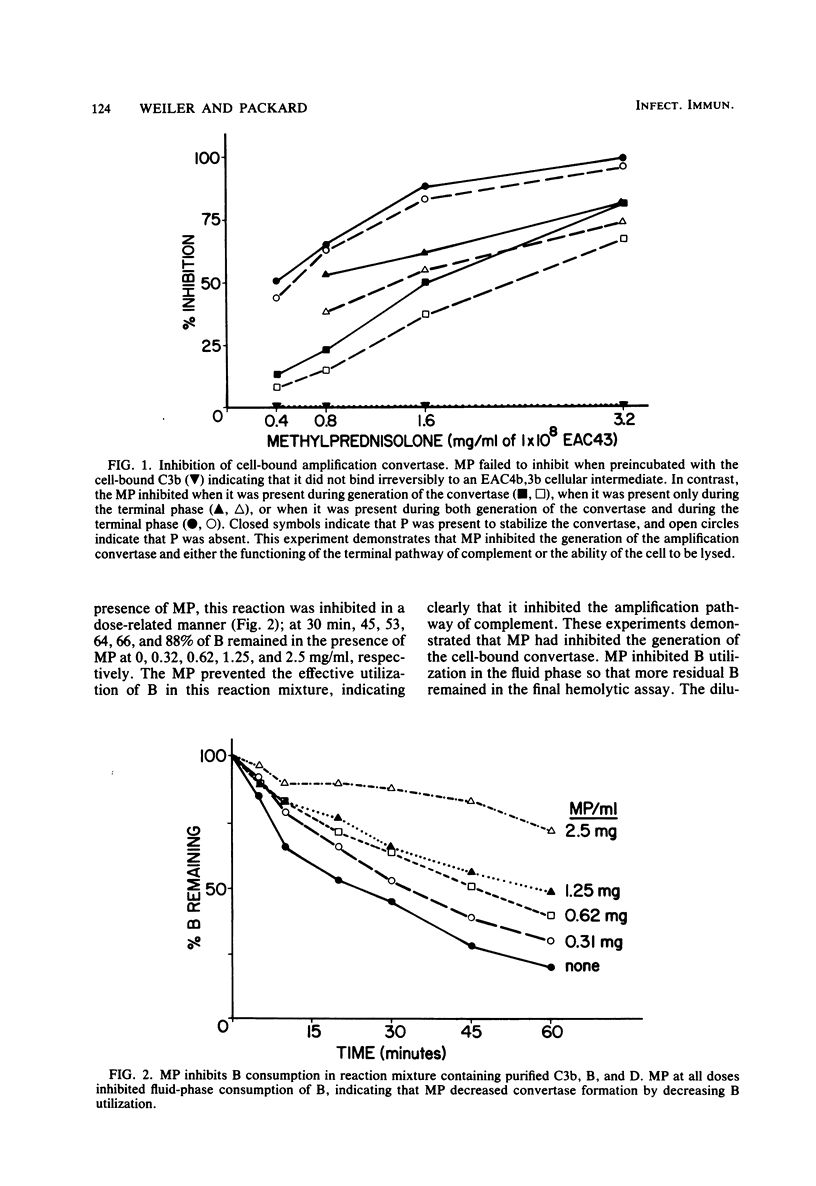
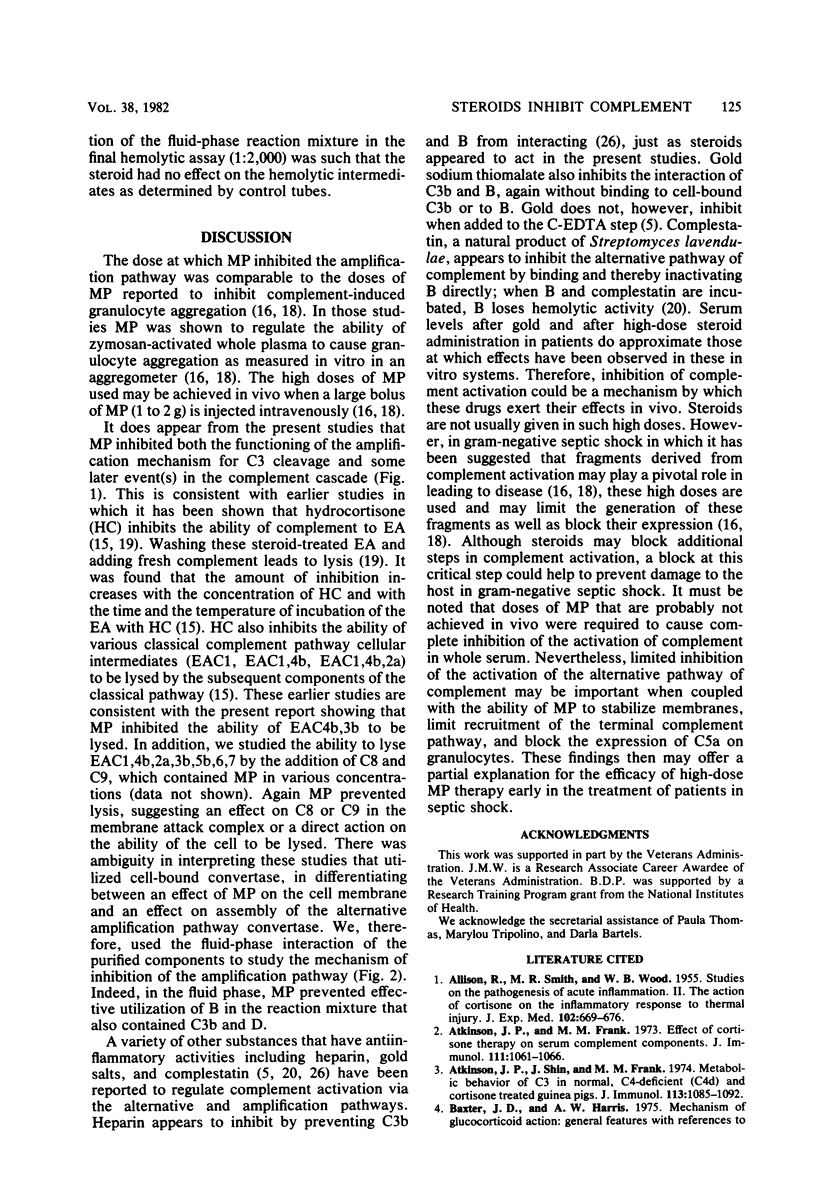
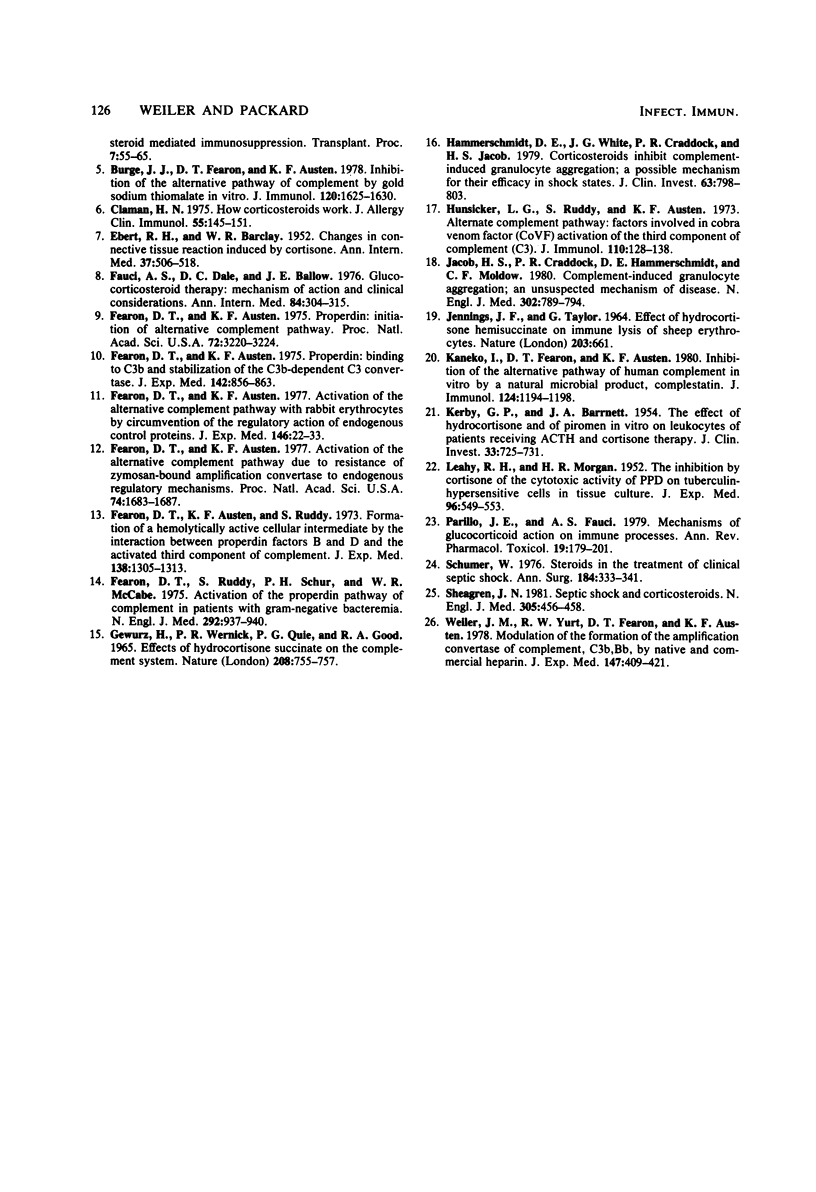
Selected References
These references are in PubMed. This may not be the complete list of references from this article.
- ALLISON F., Jr, SMITH M. R., WOOD W. B., Jr Studies on the pathogenesis of acute inflammation. II. The action of cortisone on the inflammatory response to thermal injury. J Exp Med. 1955 Dec 1;102(6):669–676. doi: 10.1084/jem.102.6.669. [DOI] [PMC free article] [PubMed] [Google Scholar]
- Atkinson J. P., Frank M. M. Effect of cortisone therapy on serum complement components. J Immunol. 1973 Oct;111(4):1061–1066. [PubMed] [Google Scholar]
- Atkinson J. P., Shin H., Frank M. M. Metabolic behavior of C3 in normal, C4-deficient (C4D) and cortisone-treated guinea pigs. J Immunol. 1974 Oct;113(4):1085–1092. [PubMed] [Google Scholar]
- Burge J. J., Fearon D. T., Austen K. F. Inhibition of the alternative pathway of complement by gold sodium thiomalate in vitro. J Immunol. 1978 May;120(5):1625–1630. [PubMed] [Google Scholar]
- Claman H. N. How corticosteroids work. J Allergy Clin Immunol. 1975 Mar;55(3):145–151. doi: 10.1016/0091-6749(75)90010-x. [DOI] [PubMed] [Google Scholar]
- EBERT R. H., BARCLAY W. R. [Changes in connective tissue reaction induced by cortisone]. Ann Intern Med. 1952 Sep;37(3):506–518. doi: 10.7326/0003-4819-37-3-506. [DOI] [PubMed] [Google Scholar]
- Fauci A. S., Dale D. C., Balow J. E. Glucocorticosteroid therapy: mechanisms of action and clinical considerations. Ann Intern Med. 1976 Mar;84(3):304–315. doi: 10.7326/0003-4819-84-3-304. [DOI] [PubMed] [Google Scholar]
- Fearon D. T., Austen K. F. Activation of the alternative complement pathway due to resistance of zymosan-bound amplification convertase to endogenous regulatory mechanisms. Proc Natl Acad Sci U S A. 1977 Apr;74(4):1683–1687. doi: 10.1073/pnas.74.4.1683. [DOI] [PMC free article] [PubMed] [Google Scholar]
- Fearon D. T., Austen K. F. Activation of the alternative complement pathway with rabbit erythrocytes by circumvention of the regulatory action of endogenous control proteins. J Exp Med. 1977 Jul 1;146(1):22–33. doi: 10.1084/jem.146.1.22. [DOI] [PMC free article] [PubMed] [Google Scholar]
- Fearon D. T., Austen K. F. Properdin: binding to C3b and stabilization of the C3b-dependent C3 convertase. J Exp Med. 1975 Oct 1;142(4):856–863. doi: 10.1084/jem.142.4.856. [DOI] [PMC free article] [PubMed] [Google Scholar]
- Fearon D. T., Austen K. F. Properdin: initiation of alternative complement pathway. Proc Natl Acad Sci U S A. 1975 Aug;72(8):3220–3224. doi: 10.1073/pnas.72.8.3220. [DOI] [PMC free article] [PubMed] [Google Scholar]
- Fearon D. T., Austen K. F., Ruddy S. Formation of a hemolytically active cellular intermediate by the interaction between properdin factors B and D and the activated third component of complement. J Exp Med. 1973 Dec 1;138(6):1305–1313. doi: 10.1084/jem.138.6.1305. [DOI] [PMC free article] [PubMed] [Google Scholar]
- Fearon D. T., Ruddy S., Schur P. H., McCabe W. R. Activation of the properdin pathway of complement in patients with gram-negative of bacteremia. N Engl J Med. 1975 May 1;292(18):937–940. doi: 10.1056/NEJM197505012921802. [DOI] [PubMed] [Google Scholar]
- Gewurz H., Wernick P. R., Quie P. G., Good R. A. Effects of hydrocortisone succinate on the complement system. Nature. 1965 Nov 20;208(5012):755–757. doi: 10.1038/208755a0. [DOI] [PubMed] [Google Scholar]
- Hammerschmidt D. E., White J. G., Craddock P. R., Jacob H. S. Corticosteroids inhibit complement-induced granulocyte aggregation. A possible mechanism for their efficacy in shock states. J Clin Invest. 1979 Apr;63(4):798–803. doi: 10.1172/JCI109365. [DOI] [PMC free article] [PubMed] [Google Scholar]
- Hunsicker L. G., Ruddy S., Austen K. F. Alternate complement pathway: factors involved in cobra venom factor (CoVF) activation of the third component of complement (C3). J Immunol. 1973 Jan;110(1):128–138. [PubMed] [Google Scholar]
- JENNINGS J. F., TAYLOR G. EFFECT OF HYDROCORTISONE HEMI-SUCCINATE ON IMMUNE LYSIS OF SHEEP ERYTHROCYTES. Nature. 1964 Aug 8;203:661–661. doi: 10.1038/203661a0. [DOI] [PubMed] [Google Scholar]
- Jacob H. S., Craddock P. R., Hammerschmidt D. E., Moldow C. F. Complement-induced granulocyte aggregation: an unsuspected mechanism of disease. N Engl J Med. 1980 Apr 3;302(14):789–794. doi: 10.1056/NEJM198004033021407. [DOI] [PubMed] [Google Scholar]
- KERBY G. P., BARRETT J. A., Jr The effect of hydrocortisone and of piromen in vitro on leukocytes of patients receiving ACTH and cortisone therapy. J Clin Invest. 1954 May;33(5):725–731. doi: 10.1172/JCI102941. [DOI] [PMC free article] [PubMed] [Google Scholar]
- Kaneko I., Fearon D. T., Austen K. F. Inhibition of the alternative pathway of human complement in vitro by a natural microbial product, complestatin. J Immunol. 1980 Mar;124(3):1194–1198. [PubMed] [Google Scholar]
- LEAHY R. H., MORGAN H. R. The inhibition by cortisone of the cytotoxic activity of PPD on tuberculin-hypersensitive cells in tissue culture. J Exp Med. 1952 Dec;96(6):549–554. doi: 10.1084/jem.96.6.549. [DOI] [PMC free article] [PubMed] [Google Scholar]
- Parrillo J. E., Fauci A. S. Mechanisms of glucocorticoid action on immune processes. Annu Rev Pharmacol Toxicol. 1979;19:179–201. doi: 10.1146/annurev.pa.19.040179.001143. [DOI] [PubMed] [Google Scholar]
- Schumer W. Steroids in the treatment of clinical septic shock. Ann Surg. 1976 Sep;184(3):333–341. doi: 10.1097/00000658-197609000-00011. [DOI] [PMC free article] [PubMed] [Google Scholar]
- Sheagren J. N. Septic shock and corticosteroids. N Engl J Med. 1981 Aug 20;305(8):456–458. doi: 10.1056/NEJM198108203050810. [DOI] [PubMed] [Google Scholar]
- Weiler J. M., Yurt R. W., Fearon D. T., Austen K. F. Modulation of the formation of the amplification convertase of complement, C3b, Bb, by native and commercial heparin. J Exp Med. 1978 Feb 1;147(2):409–421. doi: 10.1084/jem.147.2.409. [DOI] [PMC free article] [PubMed] [Google Scholar]


